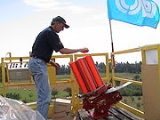
Sporting Clays
Encyclopedia
Sporting clays is a form of clay pigeon shooting
, often described as "golf with a shotgun" because a typical course includes from 10 to 15 different shooting stations laid out over natural terrain. For safety, the course size is often no smaller than 35 acres (141,640.1 m²).
Unlike trap
and skeet
, which are games of repeatable target presentations, sporting clays simulates the unpredictability of live-quarry shooting, offering a great variety of trajectories, angles, speeds, elevations, distances, and target sizes.
Safety is an important part of sporting clays. Proper ear and eye protection are mandatory, and firearms safety procedures, as listed in the National Sporting Clays Association (NSCA) Rule Book, must be followed at all times while on a course.
Clay pigeon shooting
Clay pigeon shooting, also known as clay target shooting, and formally known as Inanimate Bird Shooting, is the art of shooting at special flying targets, known as clay pigeons or clay targets, with a shotgun or any type of firearm....
, often described as "golf with a shotgun" because a typical course includes from 10 to 15 different shooting stations laid out over natural terrain. For safety, the course size is often no smaller than 35 acres (141,640.1 m²).
Unlike trap
Trap shooting
Trap shooting is one of the three major forms of competitive clay pigeon shooting . The others are skeet shooting and sporting clays. There are many versions including Olympic trap, Double trap , Down-The-Line, and Nordic trap. American trap is most popular in the United States and Canada...
and skeet
Skeet shooting
Skeet shooting is one of the three major types of competitive shotgun target shooting sports . There are several types of skeet, including one with Olympic status , and many with only national recognition.- General principles :Skeet is a recreational and competitive activity where...
, which are games of repeatable target presentations, sporting clays simulates the unpredictability of live-quarry shooting, offering a great variety of trajectories, angles, speeds, elevations, distances, and target sizes.
History
In the early 1900s, a number of British shooting schools adopted the use of clay targets to practice for driven-game shoots. Clay target shooting quickly attracted a large following. The first British Open, England’s premier sporting clays competition, was held in 1925. In 1985, the Orvis Company sponsored the first U.S. National Sporting Clays Championship, which was held in Houston, Texas and continues to promote the sport via the annual Orvis Cup held at Sandanona Shooting Grounds. Today sporting clays is one of the fastest growing sports in America, with more than three million people of all ages participating both competitively and recreationally.Equipment and safety
Because the sport is popular with a wide variety of shotgun enthusiasts, the shotguns used do not fit an exact standard; however, every shotgun used for sporting clays must be capable of shooting two cartridges of 12 gauge or smaller. The most popular shotgun configurations are over-and-under, semiautomatic, and pump-action, using traditional cartridge shot sizes of 9, 8, or 7.5.Safety is an important part of sporting clays. Proper ear and eye protection are mandatory, and firearms safety procedures, as listed in the National Sporting Clays Association (NSCA) Rule Book, must be followed at all times while on a course.
Course layout and play
A typical course consists of 10 to 15 stations, with each station presenting targets from trap machines. Usually 5 to 10 targets are shot at each station by a squad of up to six shooters for a total outing of 50 to 100 targets per person. Targets are thrown as singles and pairs. A pair of targets may be thrown as a true pair (or sim pair, i.e., thrown at the same time), as a following pair (thrown sequentially), or on report (the second clay launched on the report of the shooter’s gun). Numerous hunting conditions can be simulated by combining various speeds and angles with different types of clay targets. Each station is unique. Throughout a course, the shooters might see targets crossing from either side, coming inward, going outward, flying straight up, rolling on the ground, arcing high in the air, or thrown from towers. The possible target presentations are limited only by safety considerations, the terrain, and the imagination of the course designer. The configuration of the stations is often changed to maintain interest for the shooters and for environmental preservation of the course.External links
- Become a Better Shooter by Keeping Track of Your Scores and Analyzing Your Performance
- Find Sporting Clays Clubs near you
- Downloadable Video Shooting Tips
- Sporting Clays Shooting Tips
- Find Sporting Clays Competitions, Shooting Clubs & Talk with Other Shooters
- Network with Competitive Shotgun Shooters
- National Sporting Clays Association
- Clay Pigeon Shooting Association
- Clay Pigeon Shooting Handicap Pro System, World Sporting

